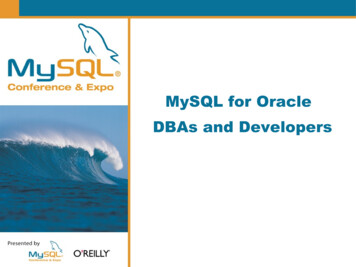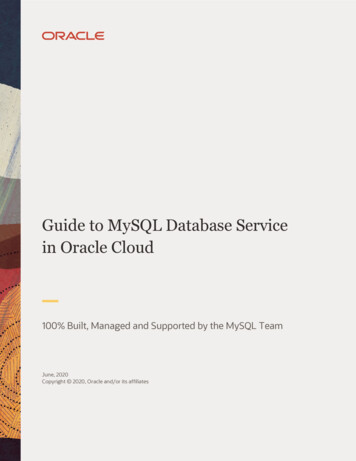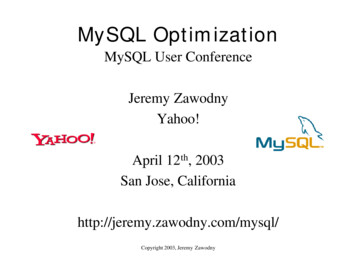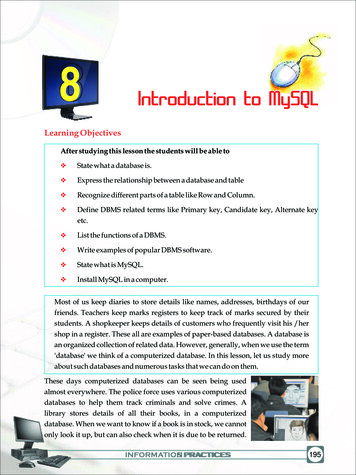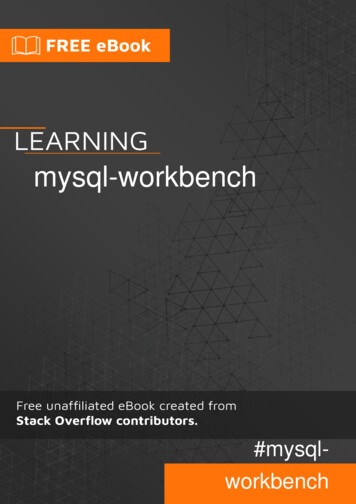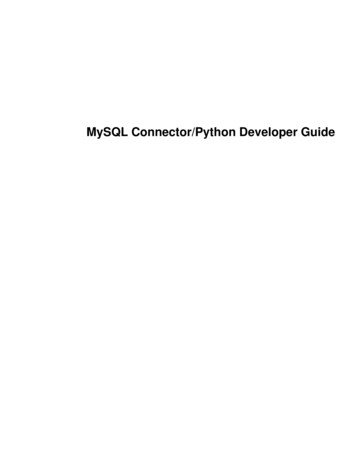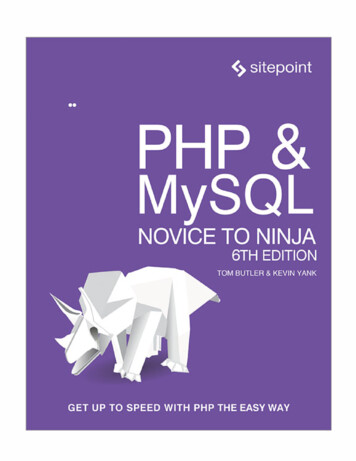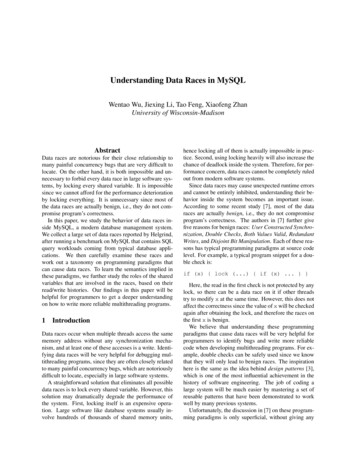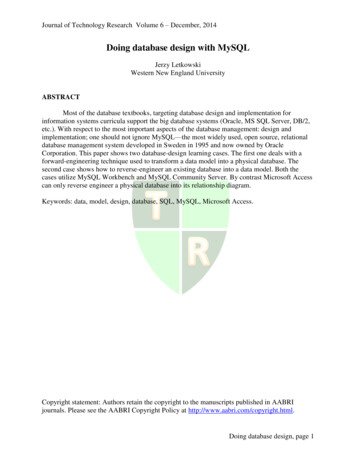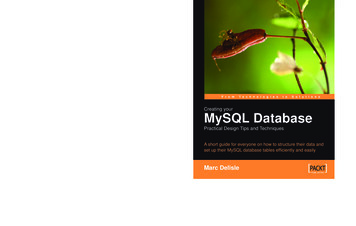
Transcription
What you will learn from this book Asking users the right questions when collecting relevant data for the system youare buildingDetecting bad structuresSound data naming techniques, both for table and column namesModeling data with future growth in mindImplementing security policies with data privileges and viewsTuning the structure for performanceProducing system documentation (data dictionary, relational schema)Testing the model with appropriate SQL queriesDatabase: Practical Design Tips and TechniquesThe popularity of MySQL and phpMyAdmin has brought many non-IT specialists to thefield of database design, usually with a view to building a dynamic website with a MySQLback end. Most users would be interested mainly in developing a functional website, butwould have little interest in learning about good practices in designing their MySQLdatabases. One reason is that MySQL design is seen as an advanced and complex topicthat requires a lot of time, which most people would not be able to afford or just would notcare to invest. This book attempts to overcome this barrier, which is both perceptional andreal, by positioning itself as a fast and easy way to learn the most important aspects ofMySQL database design.Creating your MySQLCreating your MySQL Database:Practical Design Tips andTechniquesPrices do not includelocal sales tax or VATwhere applicablePackt Publishingt oS o l u t i o n sMySQL DatabaseMarc Delisle 19.99 US 12.99 UK 16.99 EUT e c h n o l o g i e sCreating yourWho this book is written forThis book is for new web developers and MySQL database administrators who want to learnhow to build better data structures. A basic understanding of MySQL and SQL is assumed.F r o mPractical Design Tips and TechniquesA short guide for everyone on how to structure their data andset up their MySQL database tables efficiently and easilyBirmingham - Mumbaiwww.packtpub.comMarc Delisle
Creating your MySQL Database:Practical Design Tips andTechniquesA short guide for everyone on how to structure theirdata and set up their MySQL database tables efficientlyand easilyMarc DelisleBIRMINGHAM - MUMBAI
Creating your MySQL Database: Practical Design Tipsand TechniquesCopyright 2006 Packt PublishingAll rights reserved. No part of this book may be reproduced, stored in a retrievalsystem, or transmitted in any form or by any means, without the prior writtenpermission of the publisher, except in the case of brief quotations embedded incritical articles or reviews.Every effort has been made in the preparation of this book to ensure the accuracy ofthe information presented. However, the information contained in this book is soldwithout warranty, either express or implied. Neither the author, Packt Publishing,nor its dealers or distributors will be held liable for any damages caused or alleged tobe caused directly or indirectly by this book.Packt Publishing has endeavored to provide trademark information about all thecompanies and products mentioned in this book by the appropriate use of capitals.However, Packt Publishing cannot guarantee the accuracy of this information.First published: November 2006Production Reference: 1141106Published by Packt Publishing Ltd.32 Lincoln RoadOltonBirmingham, B27 6PA, UK.ISBN 1-904811-30-2www.packtpub.comCover Image by www.visionwt.com
CreditsAuthorMarc DelisleReviewerRudy LimebackDevelopment EditorLouay FatoohiAssistant Development EditorNikhil BangeraTechnical EditorMithil KulkarniEditorial ManagerDipali ChittarProject ManagerPatricia WeirIndexerBhushan PangaonkarProofreaderMartin BrooksLayouts and IllustrationsShantanu ZagadeCover DesignerShantanu Zagade
About the AuthorMarc Delisle is a member of the MySQL Developers Guild, which regroupscommunity developers — because of his involvement with phpMyAdmin. Hestarted to contribute to this popular MySQL web interface in December 1998, whenhe made the first multi-language version. He has been actively involved with thephpMyAdmin project since May 2001 as a developer and project administrator.He has worked since 1980 at Collège de Sherbrooke, Québec, Canada, as anapplication programmer and network manager. He has also been teachingnetworking, security, Linux servers, and PHP/MySQL application development.I would like to thank the whole Packt team for their support,especially Louay Fatoohi and Nikhil Bangera; their advice helpedshaping this book. My thanks also go to Rudy Limeback for hisinsight.The developers of the MySQL software have earned my respect; maythey find here my warm gratitude for their excellent product.I hope that this book will assist readers into building effective datastructures.To Carole, André, Corinne, Annie, and Guillaume, with all my love.
About the ReviewerRudy Limeback is an SQL Consultant with close to 20 years of experience usingSQL in one database system or another. He is located in Toronto, Canada but,thanks to the miracle that is the Internet, consults for clients all over the wide world.More information on SQL and Web development can be found on Rudy's website,http://www.r937.com/.
Table of ContentsPrefaceChapter 1: Introducing MySQL DesignMySQL's Popularity and ImpactThe Need for MySQL Design"What do I do Next?"Data Design StepsData as a ResourceBut this is my Data!Data ModelingOverview of the Relational ModelRule #1Rule #2Simplified Design TechniqueCase StudyOur Car DealerThe System's GoalsThe Tale of the Too Wide TableSummaryChapter 2: Data CollectingSystem Boundaries IdentificationModular DevelopmentModel FlexibilityDocument GatheringGeneral ReadingFormsExisting Computerized SystemsInterviewsFinding the Right 1
Table of ContentsPerceptionsAsking the Right Questions2121Existing Information SystemsChronological EventsSources and DestinationsUrgency21222222Avoid Focusing on Reports and ScreensData Collected for our Case StudyFrom the General ManagerFrom the SalespersonFrom the Store AssistantOther NotesSummaryChapter 3: Data Naming2222232324252527Data CleaningSubdividing Data ElementsData Elements Containing Formatting CharactersData that are ResultsData as a Column's or Table's NamePlanning for ChangesPitfalls of the Free Fields TechniqueNaming RecommendationsDesigner's CreativityAbbreviationsClarity versus Length: an ArtSuffixing272829293032333434343535The Plural FormNaming ConsistencyMySQL's Possibilities versus PortabilityTable Name into a Column NameSummaryChapter 4: Data Grouping353636363739Initial List of TablesRules for Table LayoutPrimary Keys and Table NamesData Redundancy and DependencyComposite Keys3940404142Improving the StructureScalability over TimeEmpty ColumnsAvoiding ENUM and SET44444546[ ii ]
Table of ContentsMultilingual PlanningValidating the StructureSummary484849Chapter 5: Data Structure Tuning51Data Access PoliciesResponsibilitySecurity and PrivilegesViewsStorage EnginesForeign Key ng the Query Optimizer: Analyze Table60Accessing Replication Slave ServersSpeed and Data TypesTable Size ReductionIn-Column Data EncodingCase Study's Final StructureVehiclePersonSaleOther tablesSummary60616262636568697274Chapter 6: Supplemental Case Study75Results from the Document Gathering PhasePreliminary List of Data ElementsTables and Sample ValuesCode TablesThemed TablesComposite-Key TablesAirline System Data SchemaSample QueriesInserting Sample ValuesBoarding PassPassenger ListAll Persons on a FlightSummaryIndex7580808182858787888888899091[ iii ]
PrefaceMySQL, launched in 1995, has become the most popular open source databasesystem. The popularity of MySQL and phpMyAdmin has allowed many non-ITspecialists to build dynamic websites with a MySQL backend. This book is a shortbut complete guide showing beginners how to design good data structures forMySQL. It teaches how to plan the data structure and how to implement it physicallyusing MySQL's model.What This Book CoversChapter 1 introduces the concept of MySQL, and discusses MySQL's growingpopularity and its impact as a powerful tool. This chapter gives us a brief overview ofthe relational models and Codd's rules, which are required for designing purposes. Abrief introduction to our case study — "car dealer" is provided at the end.Chapter 2 shows how to deal with the raw data information that comes from the usersor other sources, and the techniques that can help us build a comprehensive datacollection. Also, this chapter covers the exact limits of the analyzed system, how oneshould gather documents, and interview activities for our case study.Chapter 3 emphasises on transforming the data elements gathered in the collectionprocess into a cohesive set of column names. The concept of data naming is alsodiscussed in this chapter.Chapter 4 provides the technique of grouping column names into tables. Rules fortable layout, the concepts such as primary key, unique key, data redundancy, anddata dependency are covered in this chapter.Chapter 5 presents various techniques for improving our data structure in termsof security, performance, and documentation. The final data structure for the cardealer's case study is provided at the end.
PrefaceChapter 6 covers a supplemental case study about an airline system. This case studyinvolves various steps such as gathering documents, preparing preliminary listof data elements, preparing a list of tables, sample values, and queries for theairline system.What You Need for This BookBasic knowledge of SQL is required. Emphasis is made on the phpMyAdminweb-based interface for reproducing the examples, although the "mysql" commandline tool can be used. No knowledge of MySQL server administration or any specificoperating system is required.ConventionsIn this book, you will find a number of styles of text that distinguish betweendifferent kinds of information. Here are some examples of these styles, and anexplanation of their meaning.There are three styles for code. Code words in text are shown as follows: " In thiscase, we can add employee information, the employee code to the car event table ".A block of code will be set as follows:CREATE TABLE event ( code int(11) NOT NULL, description char(40) NOT NULL,PRIMARY KEY ( code )) ENGINE MyISAM DEFAULT CHARSET latin1;INSERT INTO event VALUES (1, 'washed');When we wish to draw your attention to a particular part of a code block, therelevant lines or items will be made bold:CREATE TABLE event ( code int(11) NOT NULL, description char(40) NOT NULL,PRIMARY KEY ( code )) ENGINE MyISAM DEFAULT CHARSET latin1;INSERT INTO event VALUES (1, 'washed');[ ]
PrefaceNew terms and important words are introduced in a bold-type font. Words that yousee on the screen, in menus, or dialog boxes for example, appear in our text like this:"It becomes impossible to link this "column" (for example the special paint color) to alookup table".Warnings or important notes appear in a box like this.Tips and tricks appear like this.Reader FeedbackFeedback from our readers is always welcome. Let us know what you think aboutthis book, what you liked or may have disliked. Reader feedback is important for usto develop titles that you really get the most out of.To send us general feedback, simply drop an email to feedback@packtpub.com,making sure to mention the book title in the subject of your message.If there is a book that you need and would like to see us publish, pleasesend us a note in the SUGGEST A TITLE form on www.packtpub.com or emailsuggest@packtpub.com.If there is a topic that you have expertise in and you are interested in either writingor contributing to a book, see our author guide on www.packtpub.com/authors.Customer SupportNow that you are the proud owner of a Packt book, we have a number of things tohelp you to get the most from your purchase.Downloading the Example Code for the BookVisit http://www.packtpub.com/support, and select this book from the list of titlesto download any example code or extra resources for this book. The files availablefor download will then be displayed.The downloadable files contain instructions on how to use them.[ ]
PrefaceErrataAlthough we have taken every care to ensure the accuracy of our contents, mistakesdo happen. If you find a mistake in one of our books—maybe a mistake in text orcode—we would be grateful if you would report this to us. By doing this you cansave other readers from frustration, and help to improve subsequent versions of thisbook. If you find any errata, report them by visiting http://www.packtpub.com/support, selecting your book, clicking on the Submit Errata link, and entering thedetails of your errata. Once your errata have been verified, your submission will beaccepted and the errata added to the list of existing errata. The existing errata can beviewed by selecting your title from http://www.packtpub.com/support.QuestionsYou can contact us at questions@packtpub.com if you are having a problem withsome aspect of the book, and we will do our best to address it.[ ]
Introducing MySQL DesignData design is an essential part of the application development cycle. By analogy,building an application is like building a house. Having the right tools is important,but we need a solid foundation: the data structure. However, producing a good datastructure can be a daunting challenge; the quest for a perfect data structure can leadus to new territories where many methods are available. Which one is the best? Howcan we keep our focus on the goal to achieve, without losing our time?Data design for MySQL databases is both a science and an art, and there must bea good balance between the scientific and the empiric aspects of the method. Thescientific aspect refers to information technology (IT) principles, whereas the empiricfacet is mostly based on intuitions and experience.This book is primarily oriented towards MySQL databases. It teaches how to planthe data structure and how to implement it physically using MySQL's model. Theplanning part is sometimes referred to as logical design, but it is preferable to view thelogical/physical process as a whole.MySQL's Popularity and ImpactMySQL (www.mysql.com), launched in 1995, has become the most popular opensource database system. Virtually all web providers include MySQL as part oftheir hosting plan, often on the ubiquitous LAMP (Linux, Apache, MySQL, PHP)platform. Another root cause of MySQL's popularity has been the ongoing successof phpMyAdmin (www.phpmyadmin.net), a well-established MySQL web-basedinterface. Therefore many websites use MySQL as their back-end data repository.
Introducing MySQL DesignThe Need for MySQL DesignOverall, MySQL's popularity has attracted many web developers, some of themhaving no prior IT experience. When faced with the task of transforming a staticwebsite into a dynamic/transactional one, or integrating corporate data into the site,developers are sometimes inclined to improvise a data structure. This structure (orlack of structure) may work for a certain time but later fails because of lack of depth.Maybe the system initially works because it started small, with only a few functionsplanned and implemented, but falls apart when users ask more of it. A poorlydesigned data structure can only be patched to a certain extent. It can also havescaling issues, when the initial testing has been done with only a few rows of data.The apparent facility of using the tools may hide the fact that database designdepends upon essential principles. Eluding them can render an application costlyto maintain, because correcting data structural errors after application coding hasbegun is time consuming."What do I do Next?"Here is an example of the impact of MySQL in the ranks of non-IT people. I oncesaw this question in a phpMyAdmin discussion forum – I am citing it from memory:"I've installed MySQL and phpMyAdmin, now I need directions: what do I do next?"I answered "Maybe you could create a table, and then insert some data into it. Nextyou could browse for your data."Clearly, those tools were perceived as interesting by this person, but I can only wonderwhat kind of table structure came into existence after this forum conversation.Data Design StepsWe can think of data design as a sequence of steps whose goal is to produce thephysical MySQL databases, tables, and columns necessary to support an application.[ ]
Chapter 1Starting with the outer shell, we first need to learn about our data by collecting it.We then start to organize these data elements by naming them appropriately. This isfollowed by regrouping the data elements into tables, taking into account the neededkeys. Whereas the previous steps could have been done only on paper, the final stepis to implement the model within MySQL's structure.All these steps are covered in distinct chapters of this book.Data as a ResourceBefore examining the various techniques available for design, let's think about theconcept of data itself.Organizations and enterprises use many assets, for example buildings, furniture,brains, but perhaps the most valuable asset is information or data. We remark thatdata documents the enterprise's procedures, and binds people into an ongoingexchange of information, called information flow. Computers help to formalize thisdata but we have to remember that it exists by itself.But this is my Data!When building data designs, we have to meet users and understand the enterprise'sdata flow. In an ideal world, every department, including the IT department, andevery user would collaborate in order to help data flow easily between departments.However, from time to time, one can witness two attitudes that impede thenormal data flow in enterprises. The first one is that some IT departments, having[ ]
Introducing MySQL Designthe responsibility for the computers where data resides, come to think that the data istheirs. This has the effect of keeping a certain level of secrecy that hides data andcan block the data design process. The second one is a variation of the first one, thistime caused by a user – data originates from this user and he has a tendency not toshare it.As an example of this latter attitude, let's consider accounting data. Before the PCera, accounting systems existed inside mainframes or minicomputers, and theIT department managed all data including accounting data. Since the advent ofmicrocomputers and spreadsheet applications, an accounting clerk can managea great deal of data, producing high-quality reports about it. However, this dataoften resides on his computer; he enters it, he produces the report, and he gets theaccolades for it from his boss. So the data belongs to the accounting clerk, right? Thisway of thinking impedes data flow between individuals and departments and has atendency of leading to redundant, disjoint data throughout the organization.After the data design process, bridges are built between these isolated data islandscreated by users or departments so that the data can benefit the whole enterprise. Itmay also happen that fewer islands exist and redundant data is eliminated.Data ModelingData is normally organized into an information system. This system can becompared to something as simple as a loose-sheet binder, however this bookdescribes the data design process in the context of computer-based informationsystems, or databases. Moreover, databases follow a design model, and we will usethe most popular one – the relational model.[ ]
Chapter 1The complete data collection of an enterprise is larger than what our modelwill encompass.We will build a model that represents only a subset of the data spectrum. Thequestion is which subset? We'll see in Chapter 2 that we must set boundaries to theanalyzed system's data scope.To build information systems that last, data must be tamed and molded to correctlyrepresent reality. Correctly here means: Follow the needs of the organization, including the system's boundaries Conform to the chosen data design model (here, the relational one) Possess a high degree of adaptability to adjust itself to the changingenvironmentOverview of the Relational ModelWe owe to Dr. Edgar F. Codd the concept of the relational model, from his 1970paper A Relational Model of Data for Large Shared Data Banks (http://www.acm.org/classics/nov95/toc.html). Dr. Codd later explained his model by defininga set of rules – the so-called Codd's Twelve rules (http://en.wikipedia.org/wiki/Codd%27s 12 rules). An ideal database management system (DBMS) wouldimplement all those rules, but few if any do. But this is not a problem in practicesince the benefits of the relational model are achieved even in products that do notapply all the rules. We are perfectly capable of building an efficient relational datadesign with currently available database products like MySQL.[ ]
Introducing MySQL DesignWhen dealing with data design, I believe that the most important rules are number 1and number 2. Here is a summary of these two Codd's rules.Rule #1This rule states that data is contained in tables. A table logically regroupsinformation about a certain subject, for example, cars. The tabular format – rowsand columns is the important idea here. A row describes information about a singleitem, for example, a specific car, whereas a column describes a single characteristic(or attribute) of each item, for example, its color. We will see in Chapter 3 that thedecomposition of data into well-adjusted columns is important to have a flexible anduseful structure.The intersection of a row and a column contains the value of a specific attribute fora single item. We sometimes refer to this intersection as a cell containing our data– this is the same idea as in a spreadsheet.Rule #2Data is not retrieved or referenced by physical location – find the third record in thisfile. Instead, data must be fetched by referencing a table, a unique key – the primarykey – and one or many column names. For example, with the cars table, we use thecar serial number to retrieve this car's color.This rule will be studied in Chapter 4, where we describe data grouping and theconcept of choosing keys. Proper key choosing is of utmost importance.Simplified Design TechniqueMany years ago, I started to elaborate data structures using the relational model. Iwas using a method that could be summarized by this sentence: "determine wherethe data fits the best in the structure". Then I learned about the design techniquesthat were taught to IT specialists and evolved from the relational model.The technique, which is frequently taught consists of building an entity-relationshipdiagram. In this kind of diagram, we represent nouns, for example, a car, a customer,using entities, and the relationships between them are expressed using verbs. Anexample of relationship binding two entities is "a customer buys a car". When thediagram is done, it must be somewhat transformed into a model consisting of tablesand columns, using a technique called normalization that uses many steps to refinethe model into an effective data structure.These techniques produce reports, diagrams, and eventually a theoretical datadesign that can be implemented physically in a DBMS.[ 10 ]
Chapter 1When I became familiar with those traditional techniques, I thought that for meat least they were a loss of time. Those methods teach a way but the ultimategoal – a working relational database and associated documentation can be achievedmore directly. Moreover, those techniques suffer a problem: they cannot be appliedblindfolded and mechanically. The developer always has to think about datanaming, data grouping, and choosing keys while trying to balance users' needs andconstraints imposed by: the hardware the chosen database management system planned growth time budgetI realized that the traditional techniques are taught everywhere, and I respect theteachers who teach them. But believe me, when it's time to deliver an applicationnotwithstanding the interface itself, it's important to avoid losing time tointermediate by-products and go straightforward to a working prototype. Usinga more direct method during the data design phase frees more time to refine theinterface, to catch unforeseen needs and address them.This book's goal is to teach the minimum principles one has to apply in order tobuild an effective data structure.Case StudyThe various steps of data design can be explained in a very practical way by usingtwo case studies. A case study is the best way of explaining ideas that can somewhatbecome too abstract without real examples. Chapters 1 through 5 are based on asingle case study: "Car dealership". Chapter 6 consists of another case study thatrecapitulates all the notions seen in the previous chapters.Our Car DealerSuppose we've been contacted by a car dealer who wants to computerize parts of hisbusiness. Let's describe a little bit about this business. In Chapter 2, we will examinethe data collecting phase for our system more formally.This car dealer operates at a single address. They employ nine salespersons whodutifully welcome potential customers and show them the car models that areavailable on the floor. In addition, two store assistants handle car movements, and anoffice clerk takes notes about customers' appointments. Fontax and Licorne are the[ 11 ]
Introducing MySQL Designtwo fictitious brands offered by this dealer. Each brand has a number of models, forexample Mitsou, Wanderer, and Gazelle.The System's GoalsWe want to keep information about the cars' inventory and sales. The following aresome sample questions that demonstrate the kind of information our system willhave to deal with: How many cars of Fontax Mitsou 2007 do we have in stock? How many visitors test-drove the Wanderer last year? How many Wanderer cars did we sell during a certain period? Who is our best salesperson for Mitsou, Wanderer, or overall in 2007? Are buyers mostly men or women (per car model)?Here are the titles of some reports that are needed by this car dealer: Detailed sales per month: salesperson, number of cars, revenue Yearly sales per salesperson Inventory efficiency: average delay for car delivery to the dealer, or tothe customer Visitors report: percentage of visitors trying a car; percentage of road teststhat lead to a sale Customer satisfaction about the salesperson The sales contractIn addition to this, screen applications must be built to support the inventory andsales activities. For example, being able to consult and update the appointmentschedule; consult the car delivery schedule for the next week.After this data model is built, the remaining phases of the application developmentcycle, such as screen and report design, will provide this car dealer with reports, andon-line applications to manage the car inventory and the sales in a better way.The Tale of the Too Wide TableThis book focuses on representing data in MySQL. The containers of tables in MySQL,and other products are the databases. It is quite possible to have just one table in adatabase and thus avoid fully applying the relational model concept in which tablesare related to each other through common values; however we will use the model inits normal way: having many tables and creating relations between them.[ 12 ]
Chapter 1This section describes an example of data crammed into onehuge table, also called a too wide table because it is formedwith too many columns. This too wide table is fundamentallynon-relational.Sometimes the data structure needs to be reviewed or evaluated, as it might bebased on poor decisions in terms of data naming conventions, key choosing, and thenumber of tables. Probably the most common problem is that the whole data is putinto one big, wide table.The reason for this common structure (or lack of structure) is that many developersthink in terms of the results or even of the printed results. Maybe they know howto build a spreadsheet and try to apply spreadsheet principles to databases. Let'sassume that the main goal of building a database is to produce this sales report,which shows how many cars were sold in each month, by each salesperson,describing the brand name, the car model number, and the name.SalespersonPeriodBrand NameCar modelnumberCar model name Quantityand yearsoldMurray, Dan2006-01Fontax1A8Mitsou 20073Murray, Dan2006-01Fontax2X12Wanderer 20067Murray, Dan2006-02Fontax1A8Mitsou 20074Smith, Peter2006-01Fontax1A8Mitsou 20071Smith, Peter2006-01LicorneLKCGazelle 20071Smith, Peter2006-02LicorneLKCGazelle 20076Without thinking much about the implications of this structure, we could build just onetable, sales:salespersonMurray, DanMurray, DanbrandFontaxFontaxmodel number model name year1A8Mitsou 20072X12Wanderer 2006qty 2006 013Smith, PeterFontax1A8Mitsou 2007Smith, PeterLicorne LKCGazelle 200711qty 2006 02476At first sight, we have tabularized all the information that is needed for the report.[ 13 ]
Introducing MySQL DesignThe book's examples can be reproduced using the mysqlcommand-line utility, or phpMyAdmin, a more intuitiveweb interface. You can refer to Mastering phpMyAdmin 2.8for Effective MySQL Management book from Packt Publishing(ISBN 1-904811-60-6). In phpMyAdmin, the exactcommands may be typed in using the SQL Query Window,or we can benefit from the menus and graphical dialogs.Both ways will be shown throughout the book.Here is the statement we would use to create the sales table with the mysqlcommand-line utility:CREATE TABLE sales (salesperson char(40) NOT NULL,brand char(40) NOT NULL,model number char(40) NOT NULL,model name year char(40) NOT NULL,qty 2006 01 int(11) NOT NULL,qty 2006 02 int(11) NOT NULL) ENGINE MyISAM DEFAULT CHARSET latin1;In the previous statement, while char(40) means a column with 40 characters,int(11) means an integer with a display width of 11 in MySQL.Using the phpMyAdmin web interface instead, we would obtain:[ 14 ]
Chapter 1Here we have entered sample data into
MySQL, launched in 1995, has become the most popular open source database system. The popularity of MySQL and phpMyAdmin has allowed many non-IT specialists to build dynamic websites with a MySQL backend. This book is a short but complete guide showing beginners how t

